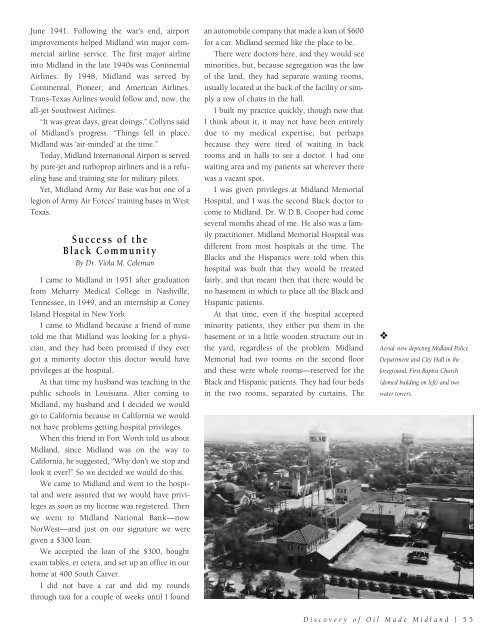Historic Midland
An illustrated history of the Midland County area, paired with the histories of companies, families and organizations that make the region great.
An illustrated history of the Midland County area, paired with the histories of companies, families and organizations that make the region great.
Create successful ePaper yourself
Turn your PDF publications into a flip-book with our unique Google optimized e-Paper software.
June 1941. Following the war’s end, airport<br />
improvements helped <strong>Midland</strong> win major commercial<br />
airline service. The first major airline<br />
into <strong>Midland</strong> in the late 1940s was Continental<br />
Airlines. By 1948, <strong>Midland</strong> was served by<br />
Continental, Pioneer, and American Airlines.<br />
Trans-Texas Airlines would follow and, now, the<br />
all-jet Southwest Airlines.<br />
“It was great days, great doings,” Collyns said<br />
of <strong>Midland</strong>’s progress. “Things fell in place.<br />
<strong>Midland</strong> was ‘air-minded’ at the time.”<br />
Today, <strong>Midland</strong> International Airport is served<br />
by pure-jet and turboprop airliners and is a refueling<br />
base and training site for military pilots.<br />
Yet, <strong>Midland</strong> Army Air Base was but one of a<br />
legion of Army Air Forces’ training bases in West<br />
Texas.<br />
Success of the<br />
Black Community<br />
By Dr. Viola M. Coleman<br />
I came to <strong>Midland</strong> in 1951 after graduation<br />
from Meharry Medical College in Nashville,<br />
Tennessee, in 1949, and an internship at Coney<br />
Island Hospital in New York<br />
I came to <strong>Midland</strong> because a friend of mine<br />
told me that <strong>Midland</strong> was looking for a physician,<br />
and they had been promised if they ever<br />
got a minority doctor this doctor would have<br />
privileges at the hospital.<br />
At that time my husband was teaching in the<br />
public schools in Louisiana. After coming to<br />
<strong>Midland</strong>, my husband and I decided we would<br />
go to California because in California we would<br />
not have problems getting hospital privileges.<br />
When this friend in Fort Worth told us about<br />
<strong>Midland</strong>, since <strong>Midland</strong> was on the way to<br />
California, he suggested, “Why don’t we stop and<br />
look it over?” So we decided we would do this.<br />
We came to <strong>Midland</strong> and went to the hospital<br />
and were assured that we would have privileges<br />
as soon as my license was registered. Then<br />
we went to <strong>Midland</strong> National Bank—now<br />
NorWest—and just on our signature we were<br />
given a $300 loan.<br />
We accepted the loan of the $300, bought<br />
exam tables, et cetera, and set up an office in our<br />
home at 400 South Carver.<br />
I did not have a car and did my rounds<br />
through taxi for a couple of weeks until I found<br />
an automobile company that made a loan of $600<br />
for a car. <strong>Midland</strong> seemed like the place to be.<br />
There were doctors here, and they would see<br />
minorities, but, because segregation was the law<br />
of the land, they had separate waiting rooms,<br />
usually located at the back of the facility or simply<br />
a row of chairs in the hall.<br />
I built my practice quickly, though now that<br />
I think about it, it may not have been entirely<br />
due to my medical expertise, but perhaps<br />
because they were tired of waiting in back<br />
rooms and in halls to see a doctor. I had one<br />
waiting area and my patients sat wherever there<br />
was a vacant spot.<br />
I was given privileges at <strong>Midland</strong> Memorial<br />
Hospital, and I was the second Black doctor to<br />
come to <strong>Midland</strong>. Dr. W.D.B. Cooper had come<br />
several months ahead of me. He also was a family<br />
practitioner. <strong>Midland</strong> Memorial Hospital was<br />
different from most hospitals at the time. The<br />
Blacks and the Hispanics were told when this<br />
hospital was built that they would be treated<br />
fairly, and that meant then that there would be<br />
no basement in which to place all the Black and<br />
Hispanic patients.<br />
At that time, even if the hospital accepted<br />
minority patients, they either put them in the<br />
basement or in a little wooden structure out in<br />
the yard, regardless of the problem. <strong>Midland</strong><br />
Memorial had two rooms on the second floor<br />
and these were whole rooms—reserved for the<br />
Black and Hispanic patients. They had four beds<br />
in the two rooms, separated by curtains. The<br />
❖<br />
Aerial view depicting <strong>Midland</strong> Police<br />
Department and City Hall in the<br />
foreground, First Baptist Church<br />
(domed building on left) and two<br />
water towers.<br />
Discovery of Oil Made <strong>Midland</strong> | 55
















